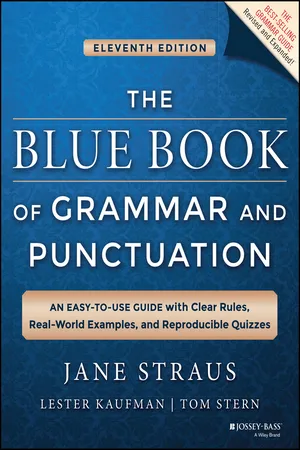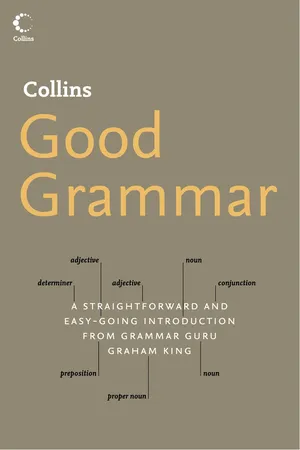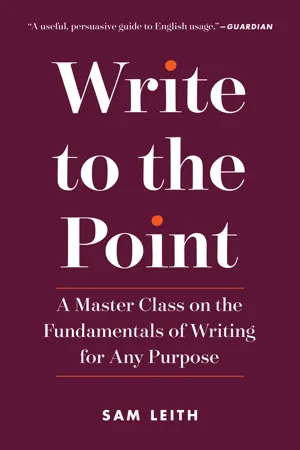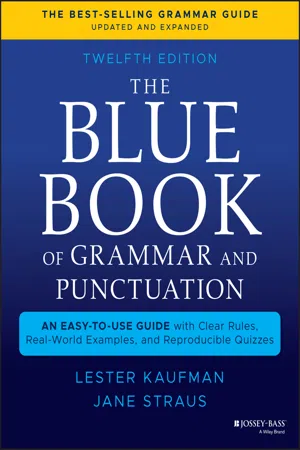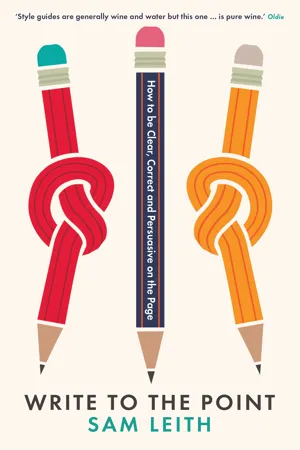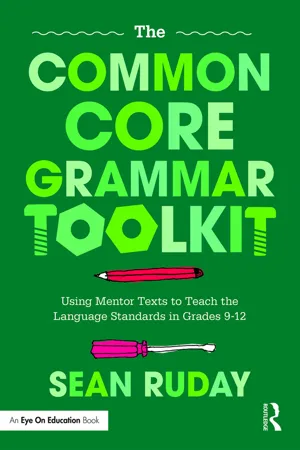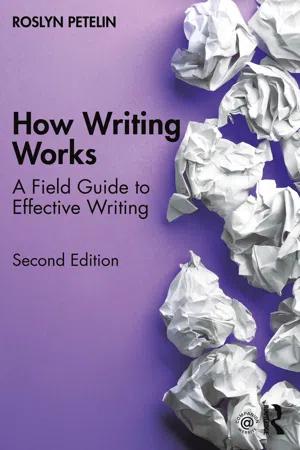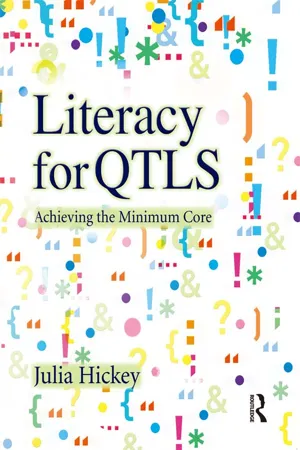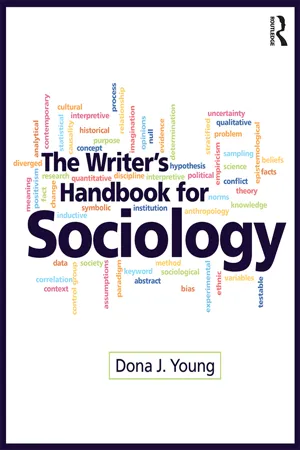Languages & Linguistics
Semicolons
Semicolons are punctuation marks used to separate independent clauses within a sentence. They can also be used to separate items in a list when the items themselves contain commas. Semicolons help to create a clear and organized structure in writing, allowing for more complex sentence constructions and enhancing readability.
Written by Perlego with AI-assistance
Related key terms
Related key terms
1 of 4
Related key terms
1 of 3
10 Key excerpts on "Semicolons"
- No longer available |Learn more
The Blue Book of Grammar and Punctuation
An Easy-to-Use Guide with Clear Rules, Real-World Examples, and Reproducible Quizzes
- Jane Straus, Lester Kaufman, Tom Stern(Authors)
- 2014(Publication Date)
- Wiley(Publisher)
semicolon is a period atop a comma. Like commas, Semicolons indicate an audible pause—slightly longer than a comma's, but short of a period's full stop.Semicolons have other functions, too. But first, a caveat: avoid the common mistake of using a semicolon to replace a colon (see the “Colons” section).Incorrect: I have one goal; to find her. Correct: I have one goal: to find her. Rule 1. A semicolon can replace a period if the writer wishes to narrow the gap between two closely linked sentences.Examples: Call me tomorrow; you can give me an answer then. We have paid our dues; we expect all the privileges listed in the contract. Rule 2. Use a semicolon before such words and terms as namely, however, therefore, that is, i.e., for example, e.g., for instance, etc., when they introduce a complete sentence. It is also preferable to use a comma after these words and terms.Example: Bring any two items; however, sleeping bags and tents are in short supply. Rule 3. Use a semicolon to separate units of a series when one or more of the units contain commas.Incorrect: The conference has people who have come from Moscow, Idaho, Springfield, California, Alamo, Tennessee, and other places as well. Note that with only commas, that sentence is hopeless. Correct: The conference has people who have come from Moscow, Idaho; Springfield, California; Alamo, Tennessee; and other places as well. Rule 4. A semicolon may be used between independent clauses joined by a connector, such as and, but, or, nor, etc., when one or more commas appear in the first clause.Example: When I finish here, and I will soon, I'll be glad to help you; and that is a promise I will keep. Colons
A colon means “that is to say” or “here's what I mean.” Colons and Semicolons should never be used interchangeably.Rule 1 - eBook - ePub
- Graham King(Author)
- 2014(Publication Date)
- Collins(Publisher)
The history of the semicolon and colon is one of confusion. There are no precise rules governing their use. Many writers argue that both marks are really stylistic rather than parenthetical devices which can easily be replaced by commas, stops and dashes. And there the argument rests.We have previously seen how the judicious use of full stops to achieve shorter sentences can aid understanding, and that is certainly the case here. But some writers, feeling that the original long sentence is, after all, about a single subject and should therefore be kept as a whole and not split apart, would turn to the semicolon to achieve unity of thought without making things hard for the reader:The history of the semicolon and colon is one of confusion; there are no precise rules governing their use; many writers argue that both marks are really stylistic rather than parenthetical devices and that they can easily be replaced by commas, stops and dashes; and there the argument rests.• To separate word groups already containing commas. Any sentence that is essentially a list should be crystal clear and easily read. Most ‘sentence lists‘ adequately separate the items with commas, but sometimes the items themselves are groups containing commas and require Semicolons for clarity. These two examples illustrate just how handy Semicolons can be:Those present included Mr and Mrs Allison, their daughters Sarah, Megan and Sue; the Smith twins; Reg and Paul Watson; Joyce, Helen and Bill Hobson; etc. The line-up consisted of Bix Beiderbecke, cornet; Al Grande, trombone; George Johnson, tenor sax; Bob Gillette, banjo; Dick Voynow, piano, and Vic Moore on drums. - eBook - ePub
Write to the Point
A Master Class on the Fundamentals of Writing for Any Purpose
- Sam Leith(Author)
- 2018(Publication Date)
- The Experiment(Publisher)
This Is Spinal Tap , the semicolon is lukewarm water. Semicolons allow you to get away with much longer sentences, and help make those sentences decipherable to the reader. If you have a succession of related thoughts, the semicolon allows you to articulate the links between them much more easily and clearly than any other mark.If those thoughts are separated by periods, any relationship of consequence, dependency, or subordination has to be inferred by the reader. You are presenting two things as if independently. He sat on the chair. He was tired. A colon staples the two things together. It insists on a relationship. But remember the colon gun is a one-shot weapon. You look very odd using more than one colon in a sentence. He sat on the chair: He was tired. But not: He sat on the chair: He was tired: It had been a long night. Where the colon insists, the semicolon suggests. Also—though not everyone would, as a stylistic decision—you can get away with using more than one semicolon as a coordinator. He sat on the chair; he was tired; it had been a long night. The two main uses of the semicolon are1. to separate independent clauses in a compound sentence; and2. to separate items in a list, particularly if the items are long and unwieldy enough that commas won’t quite do it.In The Medusa and the Snail: More Notes of a Biology Watcher (1979), the doctor Lewis Thomas wrote:The things I like best in T. S. Eliot’s poetry, especially in the Four Quartets,are the Semicolons. You cannot hear them, but they are there, laying out the connections between the images and the ideas. Sometimes you get a glimpse of a semicolon coming, a few lines farther on, and it is like climbing a steep path through woods and seeing a wooden bench just at a bend in the road ahead, a place where you can expect to sit for a moment, catching your breath.It’s a mark that divides writers like no other, though. “Do not use Semicolons,” wrote Kurt Vonnegut. “They are transvestite hermaphrodites representing absolutely nothing. All they do is show you’ve been to college.” George Orwell—another enemy of pretentiousness—took so strongly against Semicolons that he made a point of writing Coming Up for Air - eBook - ePub
The Blue Book of Grammar and Punctuation
An Easy-to-Use Guide with Clear Rules, Real-World Examples, and Reproducible Quizzes
- Lester Kaufman, Jane Straus(Authors)
- 2021(Publication Date)
- Jossey-Bass(Publisher)
semicolon is a period atop a comma. Like commas, Semicolons indicate an audible pause—slightly longer than a comma's, but short of a period's full stop.Semicolons have other functions, too. But first, a caveat: avoid the common mistake of using a semicolon to replace a colon (see the “Colons” section).Incorrect: I have one goal; to find her. Correct: I have one goal: to find her. Rule 1a. A semicolon can replace a period if the writer wishes to narrow the gap between two closely linked sentences (independent clauses).Examples: Call me tomorrow; you can give me an answer then. We have paid our dues; we expect all the privileges listed in the contract. Rule 1b. Avoid a semicolon when a dependent clause comes before an independent clause.Incorrect: Although they tried; they failed. Correct: Although they tried, they failed. Rule 2. Use a semicolon before such words and terms as namely, however, therefore, that is, i.e., for example, e.g., for instance, etc., when they introduce a complete sentence. It is also preferable to use a comma after these words and terms.Example: Bring any two items; however, sleeping bags and tents are in short supply. Rule 3. Use a semicolon to separate units of a series when one or more of the units contain commas.Incorrect: The conference has people who have come from Moscow, Idaho, Springfield, California, Alamo, Tennessee, and other places as well. Note that with only commas, that sentence is hopeless. Correct: The conference has people who have come from Moscow, Idaho; Springfield, California; Alamo, Tennessee; and other places as well.Note that a semicolon, rather than a comma, after Tennessee is correct because and other places as well also constitutes a unit of the series. Correct: Dante Martinez, a registered nurse; Susan Brooks, a dietician; and Chien-Ling Ko, a physical therapist, attended the meeting. In this case, attended the meeting is not a unit of the series and therefore is preceded only by a comma.Rule 4. A semicolon may be used between independent clauses joined by a connector, such as and - eBook - ePub
Write to the Point
How to be Clear, Correct and Persuasive on the Page
- Sam Leith(Author)
- 2017(Publication Date)
- Profile Books(Publisher)
It’s worth starting by thinking about exactly what punctuation is for. It’s one of the things, along with word order and morphology (the way words change their forms and endings), that help orient the words in a sentence. Punctuation marks are signposts through a sentence. Some of them inflect a sentence’s tone or meaning: a question or an exclamation mark change what you might think of as a sentence’s tone of voice. Some of them denote a relationship between one part of a sentence and another: brackets tell you that what’s in them isn’t part of the main flow of the sentence; a colon signals that what comes after it elaborates or depends on what goes before.Originally, though, punctuation began as a device used by scribes to help people reading aloud know where to pause. The big four marks – the comma, the semicolon, the colon and the full stop – were primarily understood to denote the length of a pause, with a full stop in some accounts of it four times as long as a comma. But those marks were taken up by printers and grammarians and repurposed as aids to semantic understanding. In effect – as with many other features of the language – prescriptive grammarians attempted to fold them into a logically consistent system. So punctuation now plays two parts: it both marks time for the reading voice and signposts grammatical relationships. Many of the arguments about punctuation arise from the overlap between its two functions. A comma can be there simply to mark a pause – but it can also have a role in marking a parenthesis or separating two clauses. As the linguist David Crystal writes: ‘This is where we see the origins of virtually all the arguments over punctuation that have continued down the centuries and which are still with us today.’*Punctuation is also subject to fashion. We live in an age that favours light punctuation. We use fewer commas than our forebears. We omit full stops at the ends of sentences in many circumstances – the titles of books, on signposts and in text messages or social media posts. We are more likely to do away with hyphens when writing compound words – preferring semicolon to semi-colon, for instance. - eBook - ePub
The Common Core Grammar Toolkit
Using Mentor Texts to Teach the Language Standards in Grades 9-12
- Sean Ruday(Author)
- 2017(Publication Date)
- Routledge(Publisher)
Figure 3.5 . In response to the first question, he explained, “The semicolon I used helped the essay because it connected the statements I made about how Nick Carraway acts and how I act. These sentences are related, so I wanted to connect them, and the semicolon let me do that without using extra words.” This student then commented on how the piece would be different without Semicolons: “If I didn’t use this semicolon, I would either have to rewrite the sentence as two separate ones or use an extra word in the sentence. I like the sentence better with a semicolon. I think making it into two short ones would be too choppy, and adding extra words might not sound as good as it does.” These statements reveal an impressive awareness of the impact that the semicolon the student used had on his piece; in addition, his responses suggest an even larger awareness of the significance of this concept to effective writing in general. This kind of deep and thoughtful understanding of the importance of a grammatical component is representative of effective grammar instruction.Final Thoughts on Purposefully Using Semicolons to Link Closely Related Independent Clauses
- The purposeful use of Semicolons to link closely related independent clauses is addressed in Common Core Language Standard L.9–10.2.A.
- Semicolons are typically found in two kinds of sentences: compound sentences, which contain two or more independent clauses, and compound-complex sentences, which contain at least two independent clauses and at least one dependent clause.
- There are two main benefits associated with the use of Semicolons in writing:
- Semicolons link short, choppy sentences.
- Semicolons eliminate the need for extra language.
- When teaching students about the purposeful and strategic use of Semicolons:
- Show students examples of published sentences that contain Semicolons and discuss the importance of the Semicolons to those sentences.
- Talk with students about how those published examples would be different if their authors did not use Semicolons.
- Have students work collaboratively to analyze the significance of semicolon use.
- Ask students to apply the writing tool of Semicolons to their own works.
- Enable students to reflect on how the Semicolons they use impact their pieces.
Passage contains an image
4 Interpret Figures of Speech and Understand Their Roles in a TextIn this chapter, we’ll consider the importance of figures of speech to effective writing. First, we’ll identify some especially useful and widely used figures of speech and then reflect on why they can enhance a written work. The next step will be for us to take a look inside a tenth-grade classroom where my students will be working to enhance their understandings of figures of speech. Finally, we’ll consider key recommendations to keep in mind when helping your students grasp this concept. - eBook - ePub
How Writing Works
A field guide to effective writing
- Roslyn Petelin(Author)
- 2021(Publication Date)
- Routledge(Publisher)
My favourite authors are: Madeleine St John and Laurie Colwin. I am very fond of: Charbonnel & Walker’s rose and violet cream chocolates.The semicolon
The semicolon has two main uses.The first is to separate closely related independent clauses that require a separation more prolonged than a conjunction such as and, but, and or. For example, Speech is silver; silence is golden.There was great excitement among many New Yorkers about the perfectly placed semicolon in the following sentence when it appeared on a message board in New York City subway stations: ‘Please put it in the trash can; that’s good news for everyone’. Louis Menand, an English professor at Harvard, pronounced the use of the semicolon by Neil Neches, the writer of the message, to be ‘impeccable’ (Roberts, 2008).Lewis Thomas (1979), in his ‘Notes on punctuation’, enthuses about the semicolon:The semicolon tells you that there is still some question about the preceding full sentence; something needs to be added . . . It is almost always a greater pleasure to come across a semicolon than a full stop. The full stop tells you that is that; if you didn’t get all the meaning you wanted or expected, you got all the writer intended to parcel out and now you have to move along. But with a semicolon there you get a pleasant little feeling of expectancy; there is more to come; read on; it will get clearer.(p. 126) - eBook - ePub
Literacy for QTLS
Achieving the Minimum Core
- Julia Hickey(Author)
- 2013(Publication Date)
- Routledge(Publisher)
Table 6.2 .Table 6.2 Advanced punctuationSemi-colon ;The separation indicated by a semi-colon is stronger than the pause indicated by a comma. • It is used to break up lists when each item on the list is a clause and a comma would be confusing.• It is used to indicate separate clauses within sentences. David Crystal (2003) describes it as the punctuation equivalent of the word and . This means that it can link two separate sentences into one compound sentence.It is important to check your punctuation; use the grammar check with the punctuation option turned on.Checkpoints Not sure whether to use a colon or a semi-colon? If the two clauses seem equally balanced, use a semi-colon. The best check for this is whether each clause could stand on its own as a short sentence.Do not use a capital letter after a semi-colon.Colon :It is stronger than a semi-colon but has less pausing power than a full stop. • It can be used to introduce an example, quotation or a list.• It can also be used to link a series of separate clauses in the second part of a sentence.Poorly punctuated work creates an impression: a bad one.Checkpoints Not sure whether to use a colon or a semi-colon? If the first part of the sentence leads to the information contained in the second part of the sentence, use a colon. The second clause should not be able to stand on its own as a short sentence if you choose to use a colon.Do not use a capital letter after a colon.• Apostrophes
An apostrophe (‘) has two uses.• It shows omission (where letters have been missed out from a word or words have been missed from a phrase). Can’t is short for cannot. Would’ve is the shortened form of would have - eBook - ePub
"Stops", Or How to Punctuate
A Practical Handbook for Writers and Students
- Paul Allardyce(Author)
- 2007(Publication Date)
- Perlego(Publisher)
XXII. When a sentence consists of two or more independent clauses not joined by conjunctions, the clauses are separated by Semicolons.To command a crime is to commit one; he who commands an assassination, is by every one regarded as an assassin. His knowledge was too multifarious to be always exact; his pursuits were too eager to be always cautious.If the conjunction "and" were inserted in the last sentence, the comma would be used instead of the semicolon. A conjunction forms a bridge over the gap between two statements, and, where they are neither long nor complicated, we pass from one to the other without noticing any distinct break. But there is such a break when the conjunction is omitted, and therefore we use a stronger point. The two parts of an antithesis are generally separated in this way.XXIII. A pause generally indicated by a comma may be indicated by a semicolon when commas are used in the sentence for other purposes. (See Introduction: Relativity of Points.)In the first sentence the semicolon enables us to group the objects enumerated. Had commas been used throughout, the reader would have been left to find out the arrangement for himself.I got several things of less value, but not all less useful to me, which I omitted setting down before: as, in particular, pens, ink, and paper; several parcels in the captain's, mate's, gunner's, and carpenter's keeping; three or four compasses, some mathematical instruments, dials, perspectives, charts, and books of navigation.In this I was certainly in the wrong too, the honest, grateful creature having no thought but what consisted of the best principles, both as a religious Christian and as a grateful friend; as appeared afterward to my full satisfaction.THE COLON
XXIV. The colon is used to indicate pauses more abrupt than those indicated by the semicolon. - eBook - ePub
- Dona Young(Author)
- 2019(Publication Date)
- Routledge(Publisher)
effectively : punctuation packages your words, developing a rhythm that affects the style and tone of your writing.Writing generally does not flow well when it consists of short, choppy sentences. However, at times short, choppy sentences create a desired dramatic effect, as in the following:Conan arrived late today. He resigned.When you want to reduce the choppy effect that short sentences can create, Semicolons can often add flow to your writing, but not always. Consider the following example:Jay priced the condo lower; he needs to relocate.In the previous example, connecting the independent clauses with a semicolon does not necessarily reduce the choppy effect. The reader needs a transitional word to build a bridge between the cause and the effect. Here are some ways to solve the problem through the use of conjunctions:Jay priced the condo lower since he needs to relocate.Jay priced the condo lower because he needs to relocate.Jay priced the condo lower; unfortunately , he needs to relocate.In each example above, the conjunction smoothed the flow of the writing. By giving the reader a transitional word, the reader can more readily draw a connection between the meaning of the two clauses.Recap
Punctuation is one more tool to help you connect with your reader and get your message across. Work with punctuation until you feel confident using the various marks correctly: experiment with punctuation and conjunctions until you gain a sense of how to use them effectively to express your voice.Writing Workshop
Activity A. Writing Practice
Instructions: Take out a paper that you have written within the past two years.- Edit the paper for correct use of punctuation.
- Revise three sentences using the semicolon, colon, and dash.
Activity B. Skill Building
Instructions:
Index pages curate the most relevant extracts from our library of academic textbooks. They’ve been created using an in-house natural language model (NLM), each adding context and meaning to key research topics.
Explore more topic indexes
Explore more topic indexes
1 of 6
Explore more topic indexes
1 of 4
